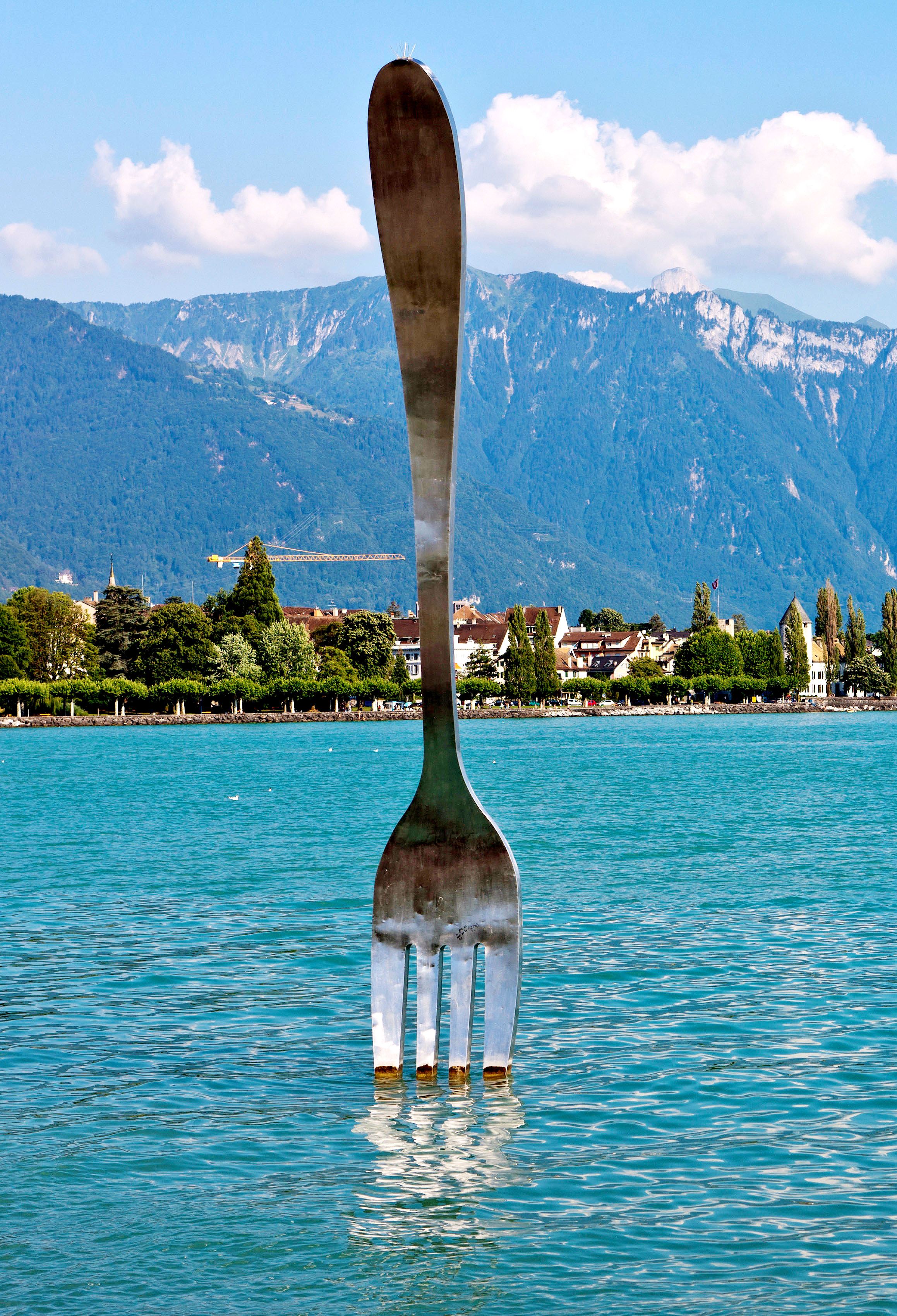Iconic statues — from Christ the Redeemer in Rio de Janeiro to China’s Spring Temple Buddha and New York City’s Statue of Liberty — are famous for their elegant, artfully sculpted designs. But some statues buck that trend. Think: metal chickens, lumpy rockets, or a teetering stack of sailing ships. Discover 10 of the world’s weirdest statues, monuments, and fountains you never knew existed.
Hand of the Desert – Atacama Desert, Chile
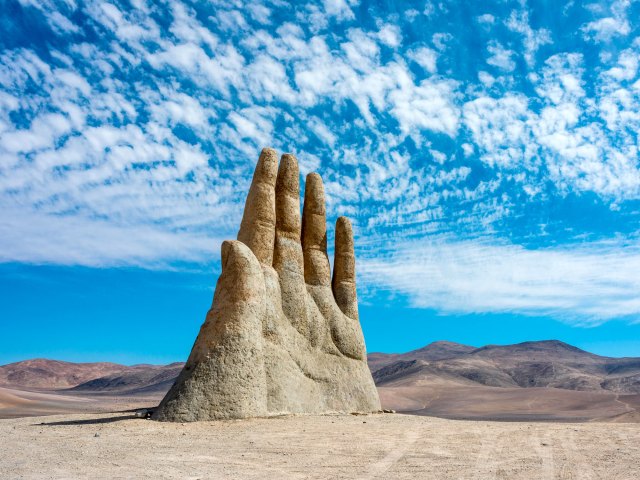
In 1992, out in Chile’s vast and desolate Atacama Desert, Santiago sculptor Mario Irarrázabal installed a striking sculpture of a left hand rising from the sand. The massive, 36-foot-tall sculpture, constructed of iron and cement, reminds some viewers of the Percy Bysshe Shelley poem “Ozymandias,” which tells the tale of a fallen monumental statue of an arrogant king lying in pieces in a desert.
The statue, commissioned by the nearby mining town of Antofagasta, has a mate — thousands of miles away in the Uruguayan coastal resort town of Punta del Este, a giant right hand by the sculptor rises from the beach, a “Monument to the Drowned.”
Man Hanging Out – Prague, Czechia
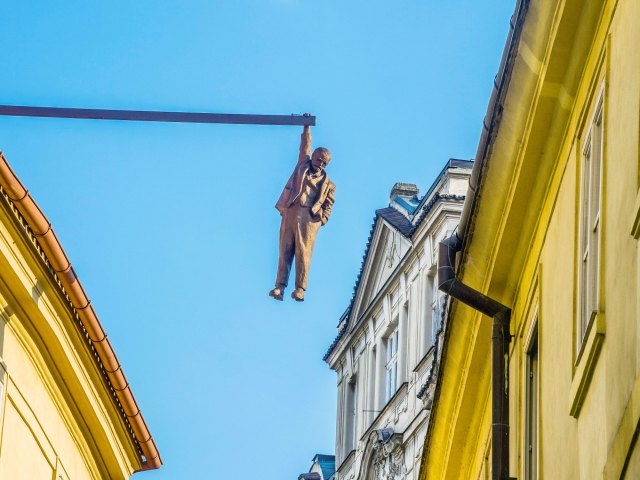
Frequently the motivation for concerned calls to the Prague police, this dangling sculpture of Sigmund Freud can be easily mistaken for a person in danger. And maybe that initial startle that viewers feel is the point of the sculpture by David Černý, a popular Prague visual and performance artist. Critics have said that the work was created to question the outsized role of intellectualism in the 20th century and to possibly portray Freud’s fear of his own death.
The sculpture depicts Freud, who was born in the Czech Republic, hanging onto a pole by one hand, above the cobbled streets of the city’s Old Town. When it was installed in 1996, “Man Hanging Out” proved so popular that the artist was invited to display the work at museums and art fairs around the world. Now it has returned to Prague and has a permanent midair home.
Floralis Generica – Buenos Aires, Argentina
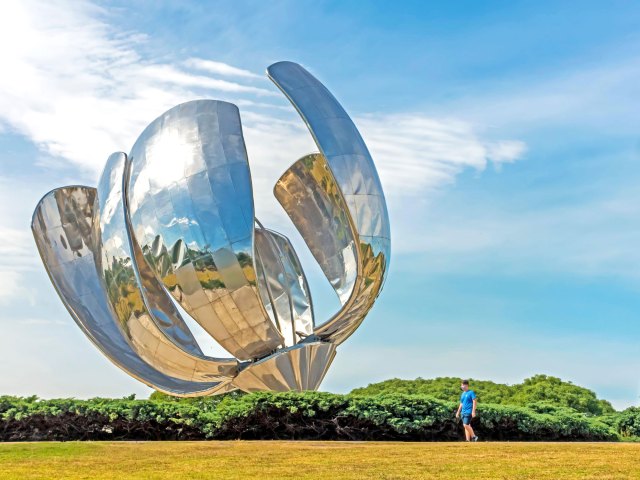
In a reflecting pool in United Nations Park in Buenos Aires’s Recoleta neighborhood, a 75-foot-tall mechanical flower made of stainless steel and aluminum opens and closes with the sun. The immense sculpture, which has a diameter of 131 feet when opened, was a gift of famed Argentinian architect Eduardo Catalano in 2002, designed by him to honor his beloved hometown.
Every morning at 8 a.m., photocells on the sculpture react to the sunlight and set off a hydraulic system that slowly opens six enormous shiny petals. The petals reflect and refract the city skyline, the sky, and the pool in which it stands, making it a popular addition to the city’s numerous public artworks. At sunset, the petals close back up, but the interior glows with colored light through the night. In its relatively short lifespan, “Floralis Generica” has become one of the most iconic symbols of Buenos Aires.
Peter the Great Statue – Moscow, Russia
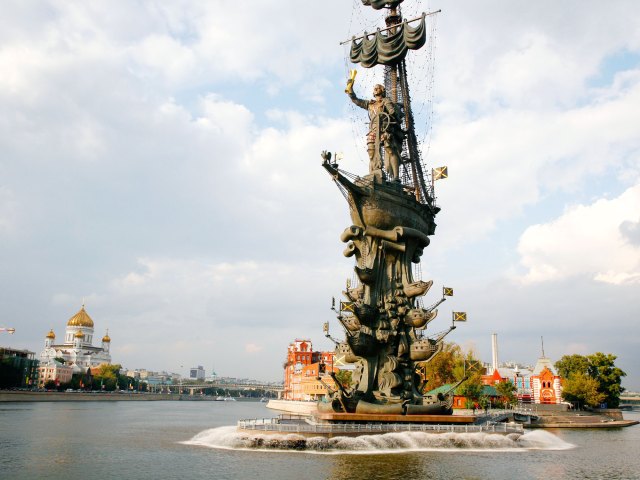
This massive statue of Peter the Great standing on the deck of a ship, which itself rests on top of a column made of several ships, was originally modeled as a memorial to honor the 500th anniversary of the first voyage of Christopher Columbus. Allegedly, the artist Zurab Tsereteli could not find a taker for a Columbus statue, so he substituted Peter the Great for the Spanish explorer and got his patron, the then-mayor of Moscow, to commission the work for a spot on the banks of the Moskva River.
Moscow’s citizens are noisy in their disapproval, which is multifaceted. First, the ungainly sculpture, which tops off at a whopping 322 feet tall (the Statue of Liberty is 305 feet with its base), blocks the view of a beautiful and historic section of the Moscow skyline. Second, Peter the Great is not considered a favorite among Muscovites: The “great” emperor disliked the city so much he moved the capital to St. Petersburg. After the mayor left office, Moscow quickly offered the statue to St. Petersburg, which politely declined the offer.
Carhenge – Alliance, Nebraska
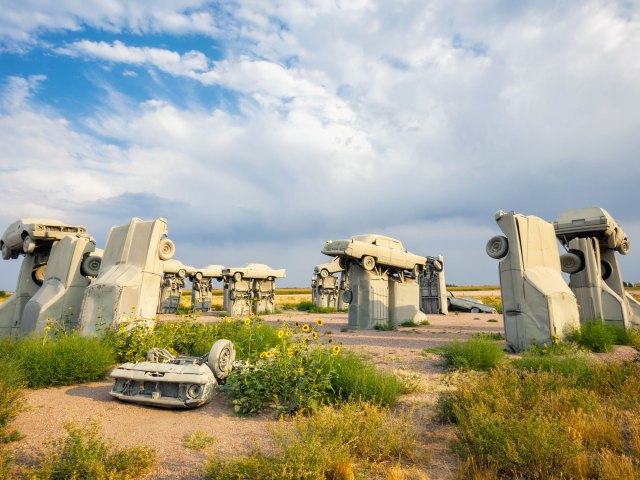
When Nebraska-born geologist Jim Reinders noticed that the proportions of the car models of the 1950s and 1960s were roughly on the same scale as the stones that make up England’s Stonehenge, he began to stockpile vintage cars with an artistic purpose. In 1987, Reinders erected a replica of Stonehenge, constructed from 38 cars, some upended with others balanced atop, like the dolmens of the original prehistoric site, and arranged them in an incomplete circle with the same 96-foot diameter. The vehicles were painted a flat grey to resemble stones (and to stop rust), but there’s no denying that the raw materials used in the sculpture were originally cars.
During the 2017 solar eclipse, the totality of the eclipse passed over Alliance, Nebraska, and Reinders’s installation. A group of over 4,000 observers, including the state governor, assembled at Carhenge to watch.
Einstein Fountain – Ulm, Germany
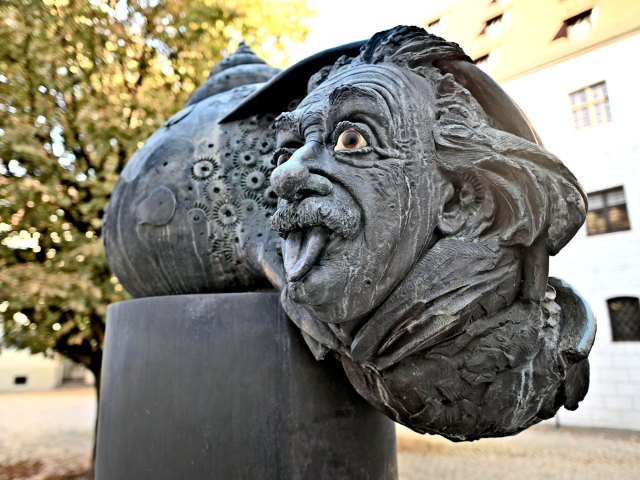
Imagine Albert Einstein’s wild-haired head cast in bronze and tucked into the sideways shell of a snail, which itself forms the top of a rocket, from whose bottom shoots out a fountain of water. Get the idea? We’ll admit, we don’t quite either. The city of Ulm, Germany, where Einstein was born in 1879 and lived for one year, erected this fountain in 1984 to honor the physicist. This chaotic creation, conceived by Jürgen Goertz, combines the man-made technology of the rocket and the perfect natural engineering of the snail shell, with the head of a genius, to somehow represent or honor his work.
Other easier-to-understand monuments to the charismatic physicist include a statue outside of the National Academy of Science in Washington D.C., a cast bronze bust at Princeton University in New Jersey, where he taught, and a lifesize bronze statue in the Griffith Observatory in Los Angeles.
Mr. Eggee, the Chicken – Chicken, Alaska
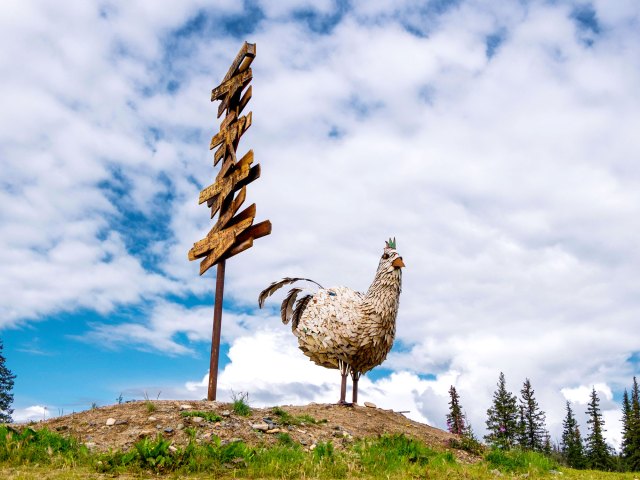
Just as you can see the namesake animals of Buffalo, New York, and Elk, Michigan, all over town on business signs and sports jerseys, a town named Chicken would surely inspire some chicken-flavored memorabilia. The tiny gold-mining town of Chicken, Alaska, near the border of Canada’s Yukon Territory, does, in fact, sport a few chicken depictions.
The most prominent, “Mr. Eggee,” was made to celebrate the annual Chickenstock music festival in 2011. Designed and constructed by a high school welding teacher (and music fan) with his shop class, the 12-foot-tall metal chicken has a basic skeletal frame adorned with metal feathers cut out of old school lockers. Transported 600 miles from the school in coastal Homer to Chicken, the sculpture now stands on the hill above the Chicken Gold Camp, an RV park.
La Fourchette – Vevey, Switzerland
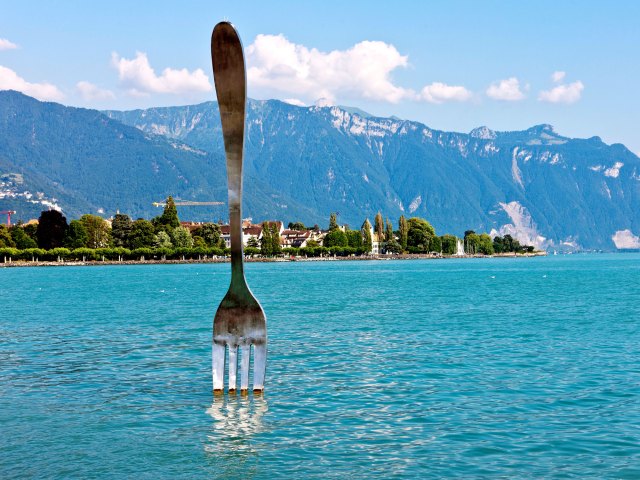
A 26-foot-tall stainless steel fork sculpture was stuck, tines down, in Lake Geneva in 1995 to commemorate the tenth anniversary of Alimentarium, a food-themed museum in Vevey, Switzerland. After a year, when the anniversary had passed, the immense fork — the work of Swiss artists Jean-Pierre Zaugg and Georges Favre — was plucked out of the lake. It was moved to mark the grounds of a Swiss factory that manufactures cutlery.
But during its tenure in the picturesque lake, the fork became a favorite landmark for the people of Vevey, and they wanted it back. Finally, the fork fans won. In 2007 it was brought back to become a permanent installation in the water off Vevey. Its mate, a giant spoon, is mounted on the side of the museum, not far from another notable statue, this one depicting former Vevey resident Charlie Chaplin.
La Tête Carrée Library – Nice, France
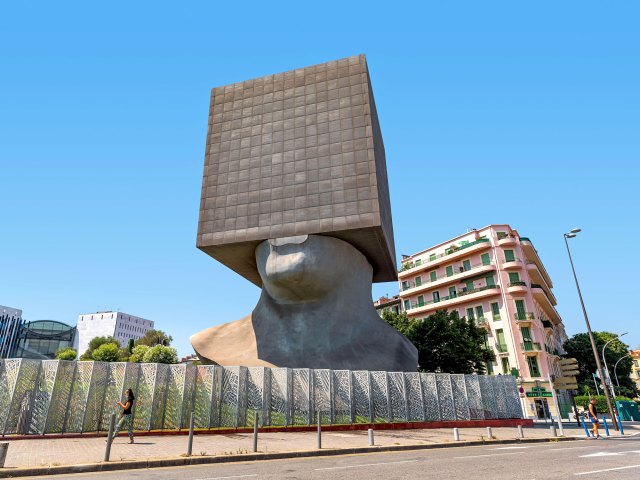
French sculptor Sacha Sosno (born Alexandre Joseph Sosnowsky) liked to mask or create voids in recognizable representations — a rectangular hole in the middle of a realistically sculpted torso, for instance, or the head, hoofs and tail of a galloping horse, its body replaced by a monolithic bronze block. Sosno called this the art of obliteration, believing that by withholding part of an image meant that the viewer would be forced to use their imagination to complete the work.
One image that Sosno returned to time and again was a human bust with the upper part of the head replaced by a block. In 2002, an 85-foot-tall architectural version of this image, La Tête Carrée (the Square Head), was constructed in the artist’s home city of Nice, France, to house seven floors of offices of the Louis Nucéra municipal library. The interior of the library offices are visible at night through perforations in the exterior sheath of aluminum on the building-sculpture.
Christ of the Abyss – San Fruttuoso, Italy
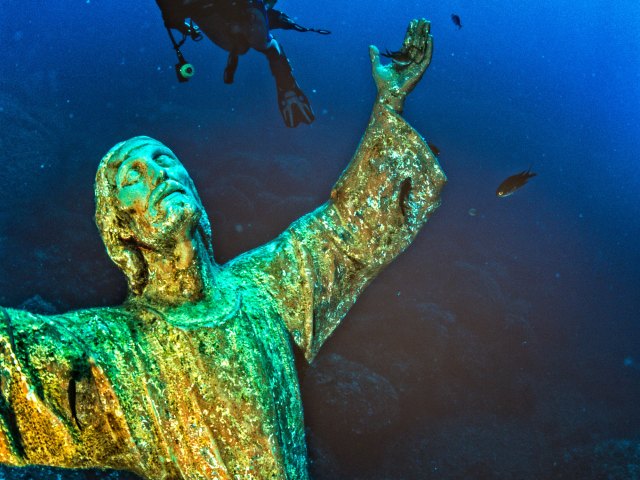
Christ of the Abyss was erected in 1954 in the waters off San Fruttuoso, Italy, on the Italian Riviera. The statue sits on the floor of the bay at a depth of almost 60 feet, near the site where an Italian diver died. Every year, on the last Sunday of July, a torch-lit mass is celebrated on the beach nearby to honor those who’ve died at sea. After the mass, divers secure floral crowns at the base of the underwater statue.
When one of the statue’s hands was knocked off by a boat anchor, the bronze statue was hauled to dry ground for repairs and restoration in 2003. The 8.5-foot-tall statue was recast several times, and replicas can be visited at underwater sculpture parks in the Florida Keys and off the coast of Grenada. A dry-land version is kept near the dive site at the church at the San Fruttuoso Abbey.
More from our network
Daily Passport is part of Optimism, which publishes content that uplifts, informs, and inspires.






